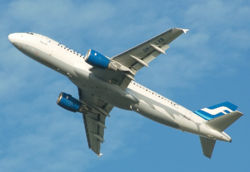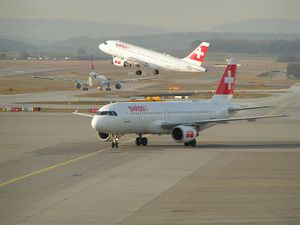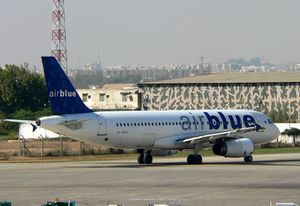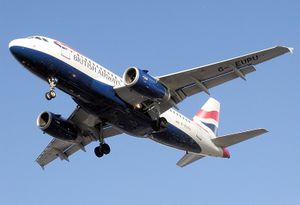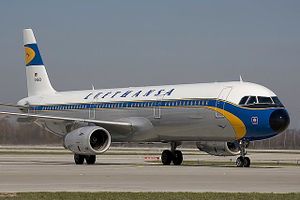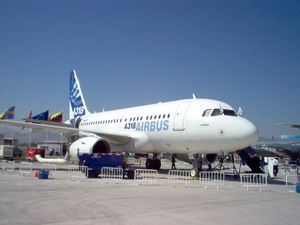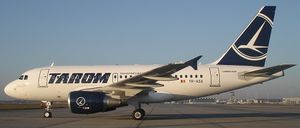PlaneSpottingWorld welcomes all new members! Please gives your ideas at the Terminal.
Airbus A320
| Airbus A320 | |
|---|---|
| A bmi A320-200 | |
| Type | Airliner |
| Manufacturer | EADS (Airbus S.A.S.) |
| Maiden flight | 1987-02-22 |
| Introduced | 1988-03-28 with Air France |
| Status | Active service |
| Primary users | US Airways (233) United Airlines (152) Northwest Airlines (146) Air France (139) |
| Number built | 3,000 |
The Airbus A320 is a short-to-medium range commercial passenger aircraft manufactured by Airbus. First delivered in 1988, the A320 pioneered the use of digital fly-by-wire flight control systems in a commercial aircraft. With 3000 built (including the A318, A319, A321 variants of the A320 family), it is the second best selling jet airliner family of all time, after the Boeing 737, its closest rival.
Contents
History
Development
After the initial success of the A300, Airbus began developing a new model aimed at replacing the world's most popular aircraft at the time, the Boeing 727. The new Airbus would be of the same size, yet offer improved operating economics and various passenger capacities. The digital technology in the A320 would herald a two-generation technological leap over the all-analog Boeing 727 and be a generation ahead of the Boeing 737-300/-400/-500 series. The A320 was targeted at the global fleet replacement requirements for the 727 and early variants of the 737.
After the oil price rises of the 1970s, Airbus needed to minimise the trip fuel costs of the A320. To that end, Airbus incorporated advanced features including fly-by-wire flight control, composite primary structures, centre-of-gravity control using fuel, glass cockpit (EFIS) and a two-person flight deck. The end result was that the A320 consumes 50% less fuel than the 727.
Production
Components from various Airbus plants are transported to the final assembly plant at Hamburg Finkenwerder for the A318/A319/A321 and to Toulouse Blagnac for the A320. Nearly all assemblies are moved using Airbus' A300-600ST 'Beluga' outsized transporters.
The Airbus A320s sold to China to be delivered between 2009 and 2012 will be assembled in the People's Republic of China in Tianjin.[1] Airbus intends to relocate Toulouse A320 final assembly activity to Hamburg as part of its Power8 organization plan begun under ex-CEO Christian Streiff.[2]
Features
Compared to other airliners of the same class, the A320 features a wider single-aisle cabin and larger overhead bins along with fly-by-wire technology. In addition, the aircraft has a spacious cargo hold equipped with large doors to assist in expedient loading and unloading of goods. These features have resulted in orders from airlines including Northwest Airlines (launch customer for United States), United Airlines, and British Airways. The A320's low maintenance and operating costs have appealed to low-cost carriers, as well. JetBlue, for example, has orders and options for up to 233 jets of the A320 family. Other low-cost carriers with significant orders include Kingfisher Airlines, IndiGo Airlines, EasyJet, Frontier Airlines, Tiger Airways and Air Asia.
The A320 features a computerised on-board maintenance system. The avionics system is designed for easy upgrade without major rework. With the exception of the very earliest A320s, most can be upgraded to the latest avionics standards, keeping the aircraft advanced even after almost 2 decades in service.
The flight deck is equipped with EFIS with sidestick controllers. At the time of the aircraft's introduction, the behavior of the fly-by-wire system (equipped with full flight envelope protection) was a new experience for many pilots. Rigorous pilot training and modification of the fly-by-wire system has greatly reduced incidents related to the EFIS system.
Two suppliers provide turbofan engines for the A320 series: CFM International with their CFM56, and International Aero Engines, offering the V2500.
Technology
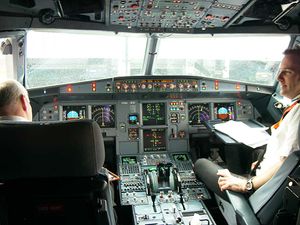
Technology used in the A320 includes:
- The first fully digital fly-by-wire flight control system in a civil airliner, hence the first with relaxed stability
- Fully glass cockpit rather than the hybrid versions found in A310, Boeing 757 and Boeing 767
- The first narrowbody airliner with a significant amount of the structure made from composites
- The ECAM (Electronic Centralized Aircraft Monitoring) concept, which is included in all Airbus aircraft produced after the A320. This system constantly displays information concerning the aircraft's engines, as well as other key systems such as flight controls, pneumatics and hydraulics, to the pilots on the two LCD displays in the centre of the flightdeck.
- Airbus recently has started installing LCD (liquid crystal) display units in the flight deck of its new A318, A319, A320, and A321 flight decks instead of the original CRT (cathode ray tube) displays. These include the main displays and the backup artificial horizon, which was an analog display prior to this. LCDs weigh less and produce less heat than CRT displays.
- Even though the A320 family is technologically advanced, the computers at the heart of the aircraft are built around CPUs roughly equivalent to the Intel 8086.[citation needed] While these chips may not offer anywhere near the power of modern processors, they are incredibly stable, and allow engineers to examine literally decades of information related to their operation.
New winglets
In 2006, Airbus tested three styles of winglet, intended to counteract the wing’s induced drag and wingtip vortices more effectively than the previous wingtip fence. Adoption of the new winglets was expected to reduce fuel consumption by one to two percent. The first design type to be tested was developed by Airbus and was based on work done by the AWIATOR program. The second type of winglet used a more blended design and was created by Winglet Technology LLC, a company based in Wichita, Kansas as well as the third type.
Two airplanes were used in the flight test evaluation campaign. F-WWBA, the first A320 produced, has been retained by Airbus for testing, and was fitted with both the first type and second type of winglets. JetBlue Airways provided the second aircraft, retrofitted by Airbus with both types of winglet.
Despite the anticipated efficiency gains and development work, Airbus announced that the new winglets will not be offered to customers, claiming that the weight of the modifications required would negate any aerodynamic benefits.[3] In addition, the change in forces from winglets add additional stress to the wing which would require long-term study to determine if structural integrity is compromised.
In service
The JAA issued the type certificate for the A320 on 26 February 1988. After entering the market in March 1988 with Air France, Airbus expanded the A320 family rapidly, launching the 185-seat A321 in 1989, the 124-seat A319 in 1993, and the 107-seat A318 in 1999.
Early incidents
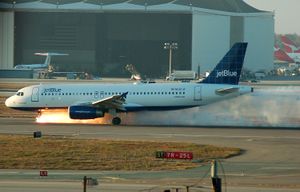
Early crashes, including the Air France A320 crash during an airshow in Habsheim, France, on 26 June 1988, dented the image of the A320 and its new computer controlled fly-by-wire technologies. The cause of the crash remains in dispute, as the investigation was hindered by the tampering of essential evidence[4]. Officially, the crash was attributed to pilot error[5]. However other third-party investigations suggest that the new computer systems and previously known deficiencies of the aircraft were the actual cause of the accident. Unfortunately, most of the computer bugs can not be fixed without fear of causing more bugs within the complex flight control system. One bug reversed the direction of the roll on the Captain's controller. [6] The RISKS Digest can be searched to find bugs that have been found within the A320 fly-by-wire system and other systems, [7].
Competition

The A320 family was developed to compete against the Boeing 737 Classics (-300/-400/-500) and the McDonnell Douglas MD-80/90 series, and has since faced challenges from the Boeing 737 Next-Generation (-600/-700/-800/-900) and the Boeing 717 during its almost two decades in service. As of February 2006, the larger A320 variants only remaining competitor is the Boeing 737 Next-Generation series, as the other models have ceased production. Embraer's 195 jet is also a major competitor to the A318.
Airbus has shipped 2,993 A318/A319/A320/A321s since its certification/first delivery in early 1988, with another 2,000 on firm order (January 2007). Boeing has shipped 5,082 737s since late 1967 with a further 1,277 on firm order (May 2006).[8] Based on these figures Airbus delivered on average 146 A320 series aircraft per annum, compared to 127 for Boeing's 737.
Airbus is studying a replacement for the A320 series, tentatively dubbed NSR, for "New Short-Range aircraft."[9]
Variants
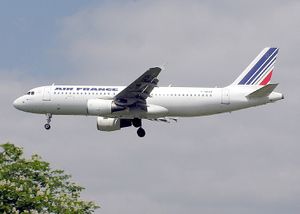
The A320 has given rise to a family of aircraft which share a common design but are slightly smaller (the A319), significantly smaller (the A318), or slightly larger (the A321). Passenger capacity ranges from 100 to 220. They compete with the Boeing 737, 757-200, and 717. All have the same pilot type-rating.
Technically, the name "A320" only refers to the original mid-sized aircraft, but it is often informally used to indicate any of the A318/A319/A320/A321 family. All variants are able to be ETOPS (Extended-range Twin-engine Operational Performance Standards) certified.
A320
The A320 series has two variants, the A320-100 and A320-200. The A320-200 is the definitive version as only 21 A320-100s were ever produced; these aircraft, the first to be manufactured, were delivered only to Air France and British Airways (as a result of an order by British Caledonian Airways made prior to its acquistion by British Airways) and are the only A320s that lack the distinctive "wingtip fences". The A320-200 features wingtip fences and increased fuel capacity over the A320-100 for increased range, other than that differences are minimal.
Typical range with 150 passengers for the A320-200 is about 2,900 nautical miles (5,400 km). It is powered by two CFMI CFM56-5 or IAE V2500 with thrust ratings between 25,500 to 27,000 pounds force (113 kN to 120 kN).
The direct Boeing competitor is the 737-800.
A319
This is a shortened, minimum change version of the A320. With virtually same fuel capacity as the A320-200, and fewer passengers, the range with 124 passengers in 2-class configuration extends to 3,900 nautical miles (7,200 km), the highest in its class. The A320 and A319 are the most popular variants of the A320 family. In 2003 easyJet took delivery of A319s with smaller galleys (as easyJet does not serve meals) and 156 seats in a single class configuration. To satisfy evacuation regulations additional over-wing exits were included.
The direct Boeing competitor is the 737-700.
The massive easyJet order of 120 A319s plus 120 options was among the biggest aircraft sales deals in recent times, rivaled only by chief competitor Ryanair's order for Boeing 737 aircraft.
It is powered by the same types of engine as the A320. JAA certification and service entry, with Swissair, took place in April 1996.
Northwest Airlines holds the record for the shortest scheduled A319 service from Bishop International Airport in Flint, MI to Detroit's Detroit Metro Airport, a distance of about 57 miles (91 km).
A319CJ

This is the corporate jet version of the A319. It incorporates extra fuel tanks which are installed in the cargo compartment giving a range of 6,500 nautical miles (12,000 km). Upon resale the aircraft can be reconfigured as a standard A319 by removing its extra tanks, thus maximizing its resale value. It is also known as the ACJ, or Airbus Corporate Jet.
The A319 is used by the Escadron de transport, d'entraînement et de calibrage which is in charge of transportation for France's officials. Since 2003, an ACJ is the main presidential aircraft of Brazil.
The aircraft seats up to 39 passengers but may be outfitted by the customers into any configuration. DaimlerChrysler, Reliance Industries and PrivatAir are among its users. The A319CJ competes with other corporate jets such as the Gulfstream V, the Boeing 737-700 based Boeing Business Jet (BBJ), and Bombardier's Global Express. It is powered by the same engine types as the A320.
A319LR
This version features an all-business class layout with 48 seats, specifically tailored for exclusive business class services on intercontinental routes. The A319LR, compared to the A319CJ, has four auxiliary fuel tanks instead of six. Typical range is 4,500 nautical miles (8,300 km).
Lufthansa operates a premium business service between Germany and the USA using a fleet of A319LRs operated by the Swiss PrivatAir. However, Qatar Airways fit their A319LRs with standard seatings with 110 seats.
The closest Boeing equivalent is the 737-700ER.
A321
This is a lengthened, minimum change version of the A320. The wing area is slightly enlarged and the undercarriage is strengthened, and higher thrust variants of either the CFM56 or the V2500 are used. The A321's closest Boeing equivalents are the 737-900/-900ER and the 757-200, though the A321 lacks the 757's transatlantic flight range and "hot and high" operation capabilities due to less powerful engines. Type certification was awarded in December 1993 by the JAA.
Typical range with 186 passengers for the A321-100 is about 2,300 nautical miles (4,300 km). It is powered by two CFM56-5 or IAE V2500 engines with a thrust rating of 31,000 pounds force (138 kN).
The A321-200 has extra fuel capacity bringing the range with 186 passengers up to about 3,000 nautical miles (5,500 km). The A321-200 is powered by two CFM56-5 or IAE V2500 engines with a thrust rating of about 33,000 pounds force (147 kN).
A318
The A318, also known as the "Mini-Airbus" or "baby 'bus", is the smallest member of the A320 family.It orgined from the AVIC1 and AIA cooperation program AE31X[1],[2].During development, it was known as the "A319M3," thus indicating its history as a direct derivative of the A319. "M3" indicates "minus three fuselage frames." The aircraft is six metres shorter and 14 tonnes lighter than the A319. Pilots who are trained on the other A320 variants may fly the A318 with no further certification, since it features the same type rating as its sister aircraft.
The A318 has a passenger capacity of 109 in a two-class configuration. It is intended to replace early Boeing 737 and Douglas DC-9 models, though it is also a rival to the 737-600. Boeing also offered their 717 aircraft as a competitor, although it was suitable primarily for regional routes and did not have the A318's range capabilities.
The A318 is available with a variety of different maximum take-off weights (MTOW) ranging from a 59 tonne, 2,750 km (1,500 nautical mile) base model to a 68 tonne, 6,000 km (3,250 nautical mile) version. The lower MTOW enables it to operate regional routes economically whilst sacrificing range and the higher MTOW allows it to complement other members of the A320 family on marginal routes. The lighter weight of the A318 gives it an operating range 10% greater than the A320, allowing it to serve some routes that the A320 would be unable to: London-Jerusalem and Singapore-Tokyo, for instance. Its main use for airlines, however, is on short, low-density hops between medium cities.
During the design process, the A318 ran into several problems. The first one was the decline in demand for new aeroplanes following the September 11, 2001 attacks. Another one was the new Pratt & Whitney turbofan engines, which burned more fuel than expected: by the time CFMI had a more efficient engine ready for market, many A318 customers had already backed out, including Air China and British Airways. America West Airlines, which had selected the Pratt & Whitney engines, amended its A318 orders, opting instead for A319 or A320 aircraft. Trans World Airlines canceled a significant order for 50 A318 after being acquired by American Airlines, which does not operate any A320 family aircraft (although, neither did TWA when the order was originally placed). While Airbus was hoping to market the A318 as a regional jet alternative, laws in both the U.S. and Europe have kept it in the same class as larger aircraft for calculating landing fees and the like, so regional operators have avoided it.
It is powered by two CFM56-5 or Pratt & Whitney PW6000 with thrust ranges between 21,600 to 23,800 lbf (96 to 106 kN) thrust. Launch customers Frontier Airlines and Air France took deliveries in 2003, with Frontier receiving their models in July of that year. The price of an A318 ranges from $39 to $45 million, and operating costs are around $3,000 for a 500 mile flight.
While designing the A318, Airbus included a number of technology upgrades, many of which have been integrated into the rest of the A320 family. Some are also finding their way to the A380 jumbo aircraft. These upgrades include:
- a new touchscreen LCD panel at the flight attendants' stations in the cabin, to simplify access to environmental and communications controls
- new cabin lighting based on LED light sources, instead of halogen and fluorescent bulbs
- electrically powered backup braking systems, improving upon the older design using reserve hydraulic pressure
- the use of laser-beam welding during construction, used to fasten floor stringers to the lower fuselage shell. Laser welding eliminates the need for rivets to secure the joint, which saves weight, and is faster, saving on assembly time.
Orders for the A318 have been quite slow, only slightly better than for its direct competitor the B737-600. As of fall 2006 Airbus had received 90 orders for this model compared to 70 for the B737-600. The sales pace has been influenced by the strong sales of the Bombardier CRJ900 and Embraer E-Jets series. Notable customers were Air France, 18; Frontier Airlines, 7 (with 4 orders); LAN Chile, 20; and Mexicana, 10. In May 2006 an A318 was tested at London City Airport for steep approach compatibility.
A318 Elite
On 10 November 2005 Airbus announced the A318 Elite. The Airbus A318 Elite is aimed at the medium-range market for flights of up to 4,000 nm range, with a choice of two cabin layouts seating up to 14 and 18 passengers, and will be powered by CFM engines. Comlux became the launch customer by ordering three A318 Elite aircraft.
Incidents
(As of 3 May 2006 for the whole A320 family)
- Hull-loss Accidents: 12 with a total of 440 fatalities
- Other occurrences: 2 with a total of 0 fatalities
- Hijackings: 6 with a total of 1 fatality
- Seven incidents of nose gear malfunction, including JetBlue Airways Flight 292
Specifications
| Measurement | A318 | A319 | A320 | A321 |
|---|---|---|---|---|
| Cockpit crew | Two | |||
| Seating capacity | 117 (1-class) | 156 (1-class) | 180 (1-class) | 220 (1-class) |
| Length | 31.45 m (103 ft 2 in) | 33.84 m (111 ft) | 37.57 m (123 ft) | 44.51 m (146 ft) |
| Wingspan | 34.10 m (111 ft 10 in) | |||
| Wing Sweepback | 25° | |||
| Height | 12.56 m (41 ft 2 in) | 11.76 m (38 ft 7 in) | ||
| Cabin Width | 3.70 m (12 ft 1 in) | |||
| Fuselage Width | 3.95 m. (13 ft) | |||
| Typical empty weight | 39,300 kg | 40,600 kg | 42,400 kg | 48,200 kg |
| Maximum take-off weight | 68,000 kg (149,900 lb) | 75,500 kg (166,500 lb) | 77,000 kg (169,000 lb) | 93,500 kg (206,100 lb) |
| Cruising speed | .79 Mach | |||
| Max. speed | .82 Mach | |||
| Range fully loaded | 5,950 km or 3,200 nm | 6,800 km or 3,700 nm | 5,700 km or 3,000 nm | 5,600 km or 3,050 nm |
| Max. fuel capacity | 23,860 liters or 6,300 USG | 29,840 liters or 7,885 USG | 29,680 liters or 6,850 USG | |
| Service Ceiling | 39,000 ft | |||
| Engines | 2 X PW6022A 2 X CFM56-5 |
2 X IAE V2500 2 X CFM56-5 | ||
References
- ↑ "Airbus signs framework agreement with Chinese consortium on A320 Final Assembly Line in China." EADS Airbus official press release. October 26, 2006.
- ↑ "Airbus to base A320 production in Hamburg, 350s and 380s in Toulouse - report." Forbes. January 15, 2007.
- ↑ "Airbus rethinks plan to put winglets on A320." Kingsley-Jones, M. Flight International. October 10, 2006.
- ↑ Kilroy, Chris (1997-2006). Investigations: Air France 296. AirDisaster.com. Retrieved on 2006-06-18.
- ↑ Flight 296 invesitgation. Aviation Safety. Retrieved on 2007-02-03.
- ↑ A320 Roll Bug.
- ↑ here
- ↑ Boeing 737 Orders.
- ↑ "The 737 Story: Smoke and mirrors obscure 737 and Airbus A320 replacement studies." Flight International. February 7, 2006.
- ↑ Plane Crash in Russia Kills All On Board
- ↑ Armenian passenger jet crashes in Russia, killing 113
External links
- Official Airbus website of the A320 aircraft family
- Airliners.net: History and pictures of the A320 family,
- Airbus A318, A319, A320, A321 Production List
- The A320 Project Website (Construction of A320 Simulator)
- A320 Flightsimulator (Construction of A320 Simulator)
- A320 series program suppliers at Airframer.com
- List of A320 currently flying
Related content
Comparable aircraft
- Boeing 717
- Boeing 737
- Boeing 757-200
- Bombardier CSeries
- Dassault Mercure
- Embraer E-Jets
- Hawker-Siddeley HS121 Trident
- Tupolev Tu-204
Related lists
See also
Airbus aircraft | ||
|---|---|---|
| Civil | A300 · A300 Beluga · A310 · A320 family (A318, A319, A320, A321) · A330 · A340 · A350 · A380 |  |
| Military | A310 MRTT · A330 MRTT · A400M | |
| In development/ proposed | A350 · A400M · NSR · KC-45 | |
| Other supported types | Sud Aviation Caravelle · Aérospatiale-BAC Concorde | |
| See also | A380 production list · Airbus A380 videos | |
Lists relating to aviation | |
|---|---|
| General | Timeline of aviation · Aircraft · Aircraft manufacturers · Aircraft engines · Aircraft engine manufacturers · Airports · Airlines |
| Military | Air forces · Aircraft weapons · Missiles · Unmanned aerial vehicles (UAVs) · Experimental aircraft |
| Notable incidents and accidents | Military aviation · Airliners · General aviation · Famous aviation-related deaths |
| Records | Flight airspeed record · Flight distance record · Flight altitude record · Flight endurance record · Most produced aircraft |
ar:ايرباص ايه 321 ast:Airbus A320 ca:Airbus A320 cs:Airbus A320 de:Airbus-A320-Familie et:Airbus A320 es:Airbus A320 eu:Airbus A320 fr:Airbus A320 gl:Airbus A320 hr:Airbus A320 hy:Airbus A320 id:Airbus A320 it:Airbus A320 he:איירבוס A320 hu:Airbus A320 ms:Airbus A320 nl:Airbus A320 ja:エアバスA320 no:Airbus A320 pl:Airbus A320 pt:Airbus A320 ru:Airbus A320 simple:Airbus A320 sr:Ербас А320 фамилија fi:Airbus A320 sv:Airbus A320 zh:空中客车A320
